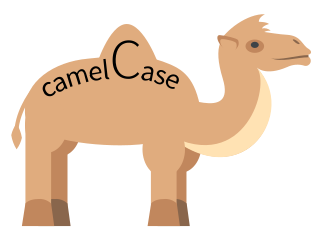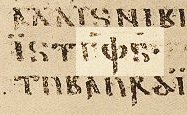 W
WIn typography, all caps refers to text or a font in which all letters are capital letters, for example: THIS IS TEXT IN ALL CAPS. All caps may be used for emphasis. They are commonly seen in legal documents, the titles on book covers, in advertisements and in newspaper headlines. Short strings of words in capital letters appear bolder and "louder" than mixed case, and this is sometimes referred to as "screaming" or "shouting". All caps can also be used to indicate that a given word is an acronym.
 W
WIn German, a medial capital I is a non-standard, mixed case typographic convention used to indicate gender inclusivity for nouns having to do with people, by using a capital letter 'I' inside the word surrounded by lower-case letters. An example is the word LehrerInnen. With a lower case I in that position, Lehrerinnen is just the standard word for "female teachers".
 W
WCamel case is the practice of writing phrases without spaces or punctuation, indicating the separation of words with a single capitalized letter, and the first word starting with either case. Common examples include "iPhone" and "eBay". It is also sometimes used in online usernames such as "johnSmith", and to make multi-word domain names more legible, for example in promoting "EasyWidgetCompany.com".
 W
WCaps Lock ⇪ Caps Lock is a button on a computer keyboard that causes all letters of bicameral scripts to be generated in capital letters. It is a toggle key: each press reverses the previous action. Some keyboards also implement a light, to give visual feedback about whether it is on or off. Exactly what Caps Lock does depends on the keyboard hardware, the operating system, the device driver, and the keyboard layout. Usually, the effect is limited to letter keys. Letters of non-bicameral scripts and non-letter characters are generated normally.
 W
WThe English word god comes from the Old English god, which itself is derived from the Proto-Germanic *ǥuđán. Its cognates in other Germanic languages include guþ, gudis, guð, god, and got.
 W
WLetter case is the distinction between the letters that are in larger uppercase or capitals and smaller lowercase in the written representation of certain languages. The writing systems that distinguish between the upper and lowercase have two parallel sets of letters, with each letter in one set usually having an equivalent in the other set. The two case variants are alternative representations of the same letter: they have the same name and pronunciation and are treated identically when sorting in alphabetical order.
 W
WRoman square capitals, also called capitalis monumentalis, inscriptional capitals, elegant capitals and capitalis quadrata, are an ancient Roman form of writing, and the basis for modern capital letters.
 W
WIn typography, small caps are lowercase characters typeset with glyphs that resemble uppercase letters (capitals) but reduced in height and weight, close to the surrounding lowercase letters or text figures. This is technically not a case-transformation, but a substitution of glyphs, although the effect is often approximated by case-transformation and scaling. Small caps are used in running text as a form of emphasis that is less dominant than all uppercase text, and as a method of emphasis or distinctiveness for text alongside or instead of italics, or when boldface is inappropriate. For example, the text "Text in small caps" appears as Text in small caps in small caps. Small caps can be used to draw attention to the opening phrase or line of a new section of text, or to provide an additional style in a dictionary entry where many parts must be typographically differentiated.
 W
WTall man lettering is the practice of writing part of a drug's name in upper case letters to help distinguish sound-alike, look-alike drugs from one another in order to avoid medication errors. For example, in tall man lettering, "prednisone" and "prednisolone" should be written "predniSONE" and "predniSOLONE", respectively. The Office of Generic Drugs of the U.S. Food and Drug Administration (FDA) encourages manufacturers to use tall man lettering labels to visually differentiate their drugs' names, and a number of hospitals, clinics, and health care systems use tall man lettering in their computerized order entry, automated dispensing machines, medication admission records, prescription labels, and drug product labels.